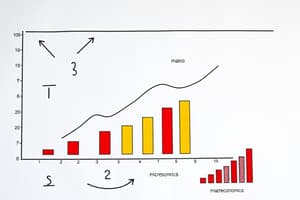Podcast
Questions and Answers
What does microeconomics primarily focus on?
What does microeconomics primarily focus on?
- Individual agents and markets (correct)
- Global trade relations
- The overall performance of the economy
- Decisions made by government entities
Which economic system is characterized by minimal government intervention?
Which economic system is characterized by minimal government intervention?
- Traditional Economy
- Mixed Economy
- Market Economy (correct)
- Command Economy
What is the law of demand?
What is the law of demand?
- As price increases, quantity demanded decreases
- As quantity demanded increases, price remains constant
- As price decreases, quantity demanded decreases
- As price decreases, quantity demanded increases (correct)
Which indicator measures the total value of goods and services produced in a country?
Which indicator measures the total value of goods and services produced in a country?
What distinguishes a monopoly from other market structures?
What distinguishes a monopoly from other market structures?
What is the purpose of fiscal policy?
What is the purpose of fiscal policy?
Which economic theory advocates for government intervention to manage demand?
Which economic theory advocates for government intervention to manage demand?
What is a common effect of trade barriers?
What is a common effect of trade barriers?
Flashcards are hidden until you start studying
Study Notes
Key Concepts in Economics
1. Definition of Economics
- The study of how individuals and societies choose to allocate scarce resources.
- Focuses on production, distribution, and consumption of goods and services.
2. Branches of Economics
- Microeconomics: Studies individual agents and markets (e.g., households, firms).
- Macroeconomics: Examines the economy as a whole (e.g., national growth, inflation).
3. Economic Systems
- Market Economy: Decisions based on supply and demand; minimal government intervention.
- Command Economy: Centralized control; government makes all economic decisions.
- Mixed Economy: Combination of market and command economies.
4. Fundamental Economic Concepts
- Scarcity: Limited nature of society's resources.
- Opportunity Cost: The cost of forgoing the next best alternative.
- Supply and Demand: Determines prices in a market economy.
- Law of Demand: As price decreases, quantity demanded increases.
- Law of Supply: As price increases, quantity supplied increases.
5. Key Economic Indicators
- Gross Domestic Product (GDP): Total value of goods and services produced in a country.
- Unemployment Rate: Percentage of the labor force that is unemployed.
- Inflation Rate: Measure of the rate at which the general level of prices for goods and services rises.
6. Types of Markets
- Perfect Competition: Many buyers and sellers; identical products.
- Monopoly: Single seller controls the market.
- Oligopoly: Few sellers dominate the market; products may be similar or differentiated.
7. Fiscal and Monetary Policy
- Fiscal Policy: Government spending and taxation decisions to influence the economy.
- Monetary Policy: Central bank actions that determine the size and rate of growth of the money supply.
8. International Trade
- Comparative Advantage: Ability of a country to produce goods at a lower opportunity cost than others.
- Trade Barriers: Tariffs, quotas, and regulations that restrict international trade.
9. Economic Theories
- Classical Economics: Emphasizes free markets and self-regulating nature.
- Keynesian Economics: Advocates for government intervention to manage demand.
- Supply-Side Economics: Focuses on boosting economic growth by increasing supply and decreasing taxes.
10. Current Economic Issues
- Income inequality, globalization effects, environmental sustainability, and economic recessions.
Definition of Economics
- Economics studies the allocation of scarce resources by individuals and societies.
- It covers production, distribution, and consumption of goods and services.
Branches of Economics
- Microeconomics: Focuses on individual agents like households and firms, analyzing their interactions and decision-making in markets.
- Macroeconomics: Looks at the economy as a whole, focusing on national growth, inflation, and overall economic performance.
Economic Systems
- Market Economy: Relies on supply and demand for decision-making, with minimal government involvement.
- Command Economy: Features centralized control where the government makes all economic decisions.
- Mixed Economy: Integrates elements of both market and command economies for a balanced approach.
Fundamental Economic Concepts
- Scarcity: The limited availability of resources forces choices and prioritization.
- Opportunity Cost: Represents the potential benefits lost when one alternative is chosen over another.
- Supply and Demand: Core principles that dictate pricing structures in a market economy.
- Law of Demand: Indicates that as prices decrease, the quantity demanded typically increases.
- Law of Supply: Suggests that as prices increase, the quantity supplied usually increases.
Key Economic Indicators
- Gross Domestic Product (GDP): Measures the total economic output of goods and services in a country.
- Unemployment Rate: Indicates the percentage of the labor force that is actively unemployed.
- Inflation Rate: Reflects the pace at which the general price levels for goods and services rise over time.
Types of Markets
- Perfect Competition: Characterized by many buyers and sellers trading identical products with no single entity influencing prices.
- Monopoly: A market structure where a single seller dominates production and sales.
- Oligopoly: A market dominated by a few sellers, where products may vary in similarity and differentiation.
Fiscal and Monetary Policy
- Fiscal Policy: Involves government strategies on spending and taxation to manage economic performance.
- Monetary Policy: Encompasses central bank measures to control the money supply and influence economic conditions.
International Trade
- Comparative Advantage: Concept wherein a country excels in producing a good at a lower opportunity cost than others.
- Trade Barriers: Include tariffs, quotas, and regulations that limit or control international trade activities.
Economic Theories
- Classical Economics: Promotes the idea of free markets and self-regulation without government interference.
- Keynesian Economics: Supports governmental intervention to stimulate demand during economic downturns.
- Supply-Side Economics: Focuses on enhancing economic growth through supply increases and tax reductions.
Current Economic Issues
- Major challenges include income inequality across populations, the impacts of globalization, the push for environmental sustainability, and the occurrence of economic recessions.
Studying That Suits You
Use AI to generate personalized quizzes and flashcards to suit your learning preferences.




